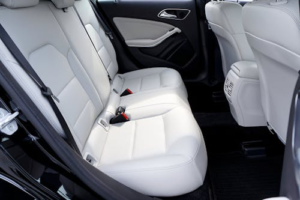Understanding the many kinds of car upholstery and how to properly clean each material is crucial for maintaining the interior of your automobile. The upholstery of your car contributes significantly to the overall appearance, feel, and value of your car, in addition to offering a comfortable place to sit. Types of car upholstery and how to clean them. The type of material used for your seats—from opulent leather to useful cloth or low-maintenance vinyl—can have a big impact on anything from long-term durability and resale value to everyday driving comfort.
The interiors of cars are constantly deteriorating. Your upholstery will eventually deteriorate due to things like food particles, spilled beverages, pet hair, muddy shoes, and even UV rays coming in through the windows. The most popular types of automobile upholstery, such as leather, fabric, vinyl, imitation leather, and suede, will be broken down in this extensive guide, along with professional cleaning and protection advice for each.
Types of car upholstery and how to clean them
The following are the different types of upholstery that will enhance the look of your car interior, as well as some tips to clean them.
1. Upholstery made of leather
Overview:
Leather upholstery is a byword for luxury in automobiles. It enhances a car’s resale value and provides a smooth, sophisticated finish. But because leather is a natural material, it needs to be regularly cared for to avoid drying out, discoloring, and cracking.
How to Clean Leather Car Seats:
- Use a strong vacuum to get rid of dust and debris from nooks and crannies.
- Use a microfiber cloth and a pH-balanced leather cleaner.
- Scrub gently in circular motions.
- Use a fresh, dry cloth to remove any excess.
Maintenance Advice:
- To maintain the leather’s softness and suppleness, use a leather conditioner.
- Steer clear of harsh chemicals like ammonia and bleach.
- To keep the automobile from fading, keep it out of direct sunshine.
- Every three to six months, condition the leather seats.
2. Upholstery made of cloth or cloth
Overview:
Due to its cost, comfort, and breathability, cloth automobile upholstery is very popular. Unlike leather, it doesn’t get as hot in the summer or as cold in the winter. It is more likely to absorb odors and get stained, though.
Cleaning Cloth Car Seats: A Guide
- To get rid of hair, crumbs, and dust, vacuum the surface.
- Use a vinegar and water solution or fabric upholstery cleaning.
- Lightly mist and use a soft-bristled brush to scrub.
- To remove stains, use a microfiber towel to blot.
- To ensure complete drying, use fans or leave the windows open.
Tips for Maintenance:
- Spills should be cleaned up right away to avoid permanent discoloration.
- If you are transporting children or pets, use seat covers.
- For a thorough cleaning, shampoo the seats every few months.
3. Upholstery made of vinyl
Overview:
Vinyl upholstery is an affordable and long-lasting choice. It is perfect for people who value convenience, water resistance, and ease of cleaning. However, it lacks the opulent feel of leather and could feel sticky in hot weather.
Cleaning Vinyl Seats: A Guide
- Use a moist towel and mild soap to clean the surface.
- Use diluted all-purpose cleanser or vinyl cleaner for tough dirt.
- Steer clear of abrasive brushes since they may cause scratches on the surface.
- Use a fresh cloth to rinse, then allow it to air dry.
Tips for Maintenance:
- Steer clear of cleansers with petroleum bases, as they can gradually deteriorate vinyl.
- To stop sun damage and cracking, use a UV protectant spray.
- Clean up spills right away to prevent the accumulation of sticky residue.

4. Leatherette, or faux leather
Overview:
Although it is composed of plastic-based materials like polyurethane, faux leather, sometimes referred to as leatherette or synthetic leather, has the appearance of real leather. It doesn’t need conditioning, is more stain-resistant, and is less costly.
How to Clean Car Upholstery Made of Faux Leather:
- Apply water and mild soap on a delicate cloth.
- Use circular strokes to clean the surface.
- Use a moist cloth to rinse, then a microfiber towel to pat dry.
- Use a synthetic leather conditioner for added protection.
Tips for Maintenance:
- Clean frequently to avoid oil and grime accumulation.
- Steer clear of harsh chemicals since they may harm the surface covering.
- To stop fading, think about using UV protection sprays.
5. Alcantara and Suede Upholstery
Overview:
High-end or performance cars use high-end materials like suede and Alcantara. They have a sporty appearance and a delicate, velvety touch. But these materials are brittle and prone to discoloration.
How to Clean Alcantara and Suede:
- To remove grime and bring back the nap, use a suede brush.
- Use a suede cleaner or a solution of white vinegar and water to remove stains.
- Don’t rub too hard; dab softly.
Allow the material to air dry entirely.
Maintenance Advice:
- Steer clear of water-based mishaps since they may create stains.
- Use Alcantara- or suede-specific protection sprays.
- Frequent brushing maintains the surface’s original appearance.
General Car Upholstery Maintenance Advice
Here are some general automobile interior cleaning guidelines, regardless of the material:
- Vacuum frequently to avoid wear and dirt accumulation.
- To preserve freshness, don’t eat or smoke in the automobile.
- To lessen UV fading and damage, use sunshades.
- To prevent stains from spreading, spot-clean them right away.
- At least twice a year, give your car’s upholstery a thorough cleaning.
Choosing the Best Upholstery Cleaner for Your Car
Every type of upholstery has different cleaning needs. The surface may get damaged or your warranty may be voided if you use the incorrect cleaning method. A brief reference is as follows:
Type of Upholstery Suggested Cleaner
- pH-balanced leather conditioner and cleaning
- Cloth: A mixture of vinegar and fabric upholstery shampoo
- Vinyl-safe cleansers or mild soap and water
- All-purpose cleanser or a gentle soap solution for faux leather
- White vinegar and a gentle brush or suede/alcantara suede cleaner
Prior to completing the application, always test cleaners on a small, discrete area.
Final Thoughts
The interior of your vehicle has a significant impact on your overall driving experience. Types of car upholstery and how to clean them? You can safeguard your investment and have a more comfortable, hygienic ride by being aware of the many types of car upholstery and knowing how to properly clean each material.
Regular cleaning and appropriate care guarantee that your car’s interior is both aesthetically pleasing and useful, regardless of whether it has leather seats or sturdy vinyl. Using the proper methods will prolong the life of your car’s upholstery and increase its resale value, whether you’re cleaning it quickly or thoroughly.
Frequently Asked Questions (FAQ)
1. How can leather automobile seats be cleaned without causing damage?
Always use a soft microfiber cloth and a pH-balanced leather cleaner to safely clean leather automobile seats. To start, vacuum to get rid of dust and debris from nooks and crannies. Next, remove any surplus product by gently cleaning the surface in circular strokes. To keep the leather soft and stop it from breaking, use a leather conditioner afterward. Steer clear of harsh chemicals that might dry out or discolor leather, such as bleach or ammonia. Use sunshades or park in a shaded area for extra protection from UV rays. Your car seats can last longer if you condition them every three to six months to keep the leather supple.
2. How can strong stains and smells be eliminated from cloth car seats?
Although cloth upholstery is susceptible to stains and odors, these issues can be resolved with basic tools. After vacuuming the fabric to get rid of any debris, use a fabric-safe upholstery cleaner or a vinegar and water solution. Use a soft-bristled brush to gently scrub, then dab with a microfiber towel. Sprinkle baking soda on the seats to get rid of odors, then vacuum again after a few hours. Use fans or leave the windows open to dry fast and avoid mold. Maintaining clean and odor-free fabric seats requires routine upkeep and prompt spill cleanup.
3. What are the finest products for maintaining vinyl car seats?
Indeed, vinyl car seats are among the simplest to keep clean. They are perfect for families and pet owners because they are resistant to dampness, spills, and stains. Vinyl can be cleaned with a cloth dipped in mild soap and water, or for more stubborn dirt, a vinyl cleaner. Steer clear of harsh chemicals or abrasive scrubbers that could scrape or deteriorate the material. After cleaning, use a UV protectant spray to avoid drying out and cracking from exposure to the sun. The life of vinyl upholstery can be prolonged and a polished appearance maintained with frequent cleaning and timely spill clearance.
4. How should real leather and imitation leather be cleaned, and what are the differences between the two?
Although it is constructed of plastic-based materials like polyurethane, faux leather, sometimes referred to as leatherette or synthetic leather, looks just like real leather. It is less expensive, less prone to stains, and requires less upkeep. Use a moist cloth and mild soap to clean the imitation leather, and then pat dry with a microfiber towel. It doesn’t require conditioning like real leather does, but UV protectant sprays may help. However, to keep it from drying out and cracking, real leather requires certain leather cleansers and conditioning. Although both are durable, genuine leather is more opulent but requires more maintenance than synthetic substitutes.
5. How can delicate materials like Alcantara or suede be safely cleaned in a car?
The soft, delicate texture of suede and alcantara needs certain cleaning techniques. To remove grime and restore texture, begin by lightly cleaning the surface with a suede brush. Spot cleaning can be done with a suede-specific cleaner or a towel moistened with white vinegar and water. Because moisture can leave lasting stains, avoid soaking the material or giving it a vigorous scrub. Let the fabric air dry completely at all times. To help prevent future stains, use preventive sprays made for suede or Alcantara. Regular brushing and meticulous spot treatment maintain the elegant appearance of these high-end fabrics.







